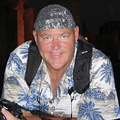
|  |  |  Vallarta Living | Art Talk | March 2009 Vallarta Living | Art Talk | March 2009  
Photo Tip of the Week: RAW vs JPEG and Let's Look at Pixels
 Larry Bennett - PVNN Larry Bennett - PVNN

| | Photo Tips of the Week are written by Larry Bennett, a professional photographer living in Puerto Vallarta. To view more of his work, visit LarryBennettPhotography.com. |  |
What are you going to do with your images? If you're shooting images for a family vacation, then JPEG is wonderful; if you're going to enlarge the images and sell them, RAW will most likely be your best bet.

I shoot in both JPEG and RAW and can change from one to the other in a few seconds, I prefer to shoot JPEG's most of the time. Shooting in RAW does give you all the control you will need for that image, you can add light, reduce light, add color, and the list goes on.

I understand RAW and use it when needed or wanted, there is a time and place for RAW images and action whale images is not it. To use camera RAW you must post process your image. Photoshop CS3, Coral Paint Shop Pro, and Lightroom are the three programs I use for post processing.

I use Picasa 3 as my storage locker and dump library. I like Picasa 3, it's a fun program without all the brain twisters that come with CS3 and some of the others. I have made enlargements up to 40x40" with no color, saturation, or pixel problems just on compressed JPEG and TIFF images.

With the newer cameras being in the 21 mg pixel category, some photographers have asked if their camera is good enough. Don't worry about this. People get so caught up in the pixel size of their camera. Pixels just mean size or "how big can I make this print?"

Some of the best whale images I have seen were shot with an 8 pixel camera. Don't get me wrong, I love pixels and plan on buying one of the new 25 pixel cameras coming out this spring, but I have taken many wonderful whale images with lower pixel cameras, and so can you.

If you're into saving space on your memory then stay away from shooting in RAW as it will eat up your memory very easy. For the amount of memory it takes to store 1 RAW image you could use the same amount of memory to store 6 JPEG images so you can see that you need a lot of memory space to shoot in RAW.

Since we are talking about memory and space, I shoot 8 GB 300 speed memory cards. I find that these work the best for me because I tend to shoot a lot of action pictures. On an average day of shooting in the bay, I shoot approximately 600 images, but will only keep about 30 of those. Remember, digital photography is free so snap away as you can never have too many images.

Finally, you are Home or Back at the Hotel

I know I mentioned this topic in my Photographing at the Beach article, but I am going to say it again, clean your equipment! For those of you using high end cameras, please listen. I have sacrificed far too many cameras to the sea gods so please learn from my mistakes, wash your equipment! Take a damp (not wet) towel and wipe it down, everything but your glass. Then dry your camera good with a dry towel. If you have canned air, it is a good idea to use it both prior and after wiping your camera to make sure all the sand and sea mist is gone.

 Photo Tips of the week are written by Larry Bennett, a professional photographer living in Puerto Vallarta. These tips are to be just tips, refer to your cameras owner's manual for specifics on your camera. Readers are welcome to enjoy Larry's website at LarryBennettPhotography.com. Photo Tips of the week are written by Larry Bennett, a professional photographer living in Puerto Vallarta. These tips are to be just tips, refer to your cameras owner's manual for specifics on your camera. Readers are welcome to enjoy Larry's website at LarryBennettPhotography.com. |

 |
|  |



